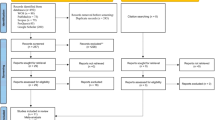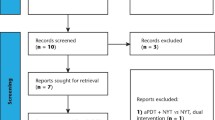Abstract
Objective
To evaluate the effectiveness of microwave disinfection in treating Candida-associated denture stomatitis (CADS).
Materials and methods
The PubMed/MEDLINE, Embase, and Scopus databases were searched for reports on randomized clinical trials (RCTs) published in English until May 2020 (PROSPERO CRD42020192062) that evaluated the treatment of CADS by using microwave disinfection. The main outcomes were the improvement of clinical signs and/or the decrease in the residual yeast present on the dentures and palatal mucosa. The mean differences, standard deviations, risk ratio, and 95% confidence interval were calculated by using the random-effects model. Heterogeneity was assessed by using Cochran’s Q test and I2 values. The level of significance was set at α = 0.05.
Results
Five RCTs with 245 participants were included. The descriptive investigations demonstrated that microwave disinfection was as effective (p > 0.05) as 0.2% chlorhexidine, 0.02% sodium hypochlorite, and topical nystatin (100.000 IU/mL), and was superior to topical miconazole in treating CADS. The metaanalysis did not show a statistical difference between microwave disinfection and nystatin (100.000 IU/mL) treatment in terms of mycological counts, cure, and recurrence rates (p > 0.05).
Conclusion
Microwave disinfection showed comparable results with those of conventional therapies for treating CADS. In addition, treatment with 650 W for 3 min once a week for 14 days had better cost-effect results, indicating both the prevention and treatment of CADS.
Clinical relevance
Our findings provide evidence regarding the treatment of CADS using microwave disinfection, and also indicating the best cost-effective option for this treatment modality.



Similar content being viewed by others
References
Távora FFF, Chocano APC, Oliveira DG et al (2019) Beneficial effects of ethyl-cyanoacrylate coating against candida albicans biofilm formation. Braz Dent J 30:266–271
Banting DW, Hill SA (2001) Microwave disinfection of dentures for the treatment of oral candidiasis. Spec Care Dent 21:4–8
Silva MM, Mima EG, Colombo AL et al (2012) Comparison of denture microwave disinfection and conventional antifungal therapy in the treatment of denture stomatitis: a randomized clinical study. Oral Surg Oral Med Oral Pathol Oral Radiol 114:469–479
Valentini-Mioso F, Maske TT, Cenci MS, Boscato N, Pereira-Cenci T (2019) Chemical hygiene protocols for complete denture: a crossover randomized clinical trial. J Prosthet Dent 121:83–89
Millsop JW, Fazel N (2016) Oral candidiasis. Clin Dermatol 34:487–494
Kurt A, Erkose-Genc G, Uzun M, Sari T, Isik-Ozkol G (2018) The effect of cleaning solutions on a denture base material: elimination of candida albicans and alteration of physical properties. J Prosthodont 27:577–583
Campanha NH, Pavarina AC, Brunetti IL, Vergani CE, Machado AL, Spolidorio DM (2007) Candida albicans inactivation and cell membrane integrity damage by microwave irradiation. Mycoses 50:140–147
Yeo CB, Watson IA, Stewart-Tull DE, Koh VH (1999) Heat transfer analysis of staphylococcus aureus on stainless steel with microwave radiation. J Appl Microbiol 87:396–401
Watanabe K, Kakita Y, Kashige N, Miake F, Tsukiji T (2000) Effect of ionic strength on the inactivation of micro-organisms by microwave irradiation. Lett Appl Microbiol 31:52–56
Moher D, Shamseer L, Clarke M et al (2015) Preferred reporting items for systematic review and meta-analysis protocols (PRISMA-P) 2015 statement. Syst Rev 4:1
Deeks J, Higgins J, Altman D, Green S (2011) Chapter 4. In: Cochrane handbook for systematic reviews of interventions version 5.1.0. (updated March 2011). The Cochrane Collaboration, London, pp 17–24
Deeks J, Higgins J, Altman D (2019) Chapter 10. In: Cochrane handbook for systematic reviews of interventions version 6.0 (updated July 2019). The Cochrane Collaboration, London Available at: https://training.cochrane.org/handbook/current/chapter-10. Accessed August 13, 2020.
de Medeiros FCFL, Kudo GAH, Leme BG, Saraiva PP, Verri FR, Honório HM, Pellizzer EP, Santiago Junior JF (2018) Dental implants in patients with osteoporosis: a systematic review with meta-analysis. Int J Oral Maxillofac Surg 47:480–491
Carvalho MV, de Moraes SLD, Lemos CAA, Santiago Júnior JF, Vasconcelos BCDE, Pellizzer EP (2019) Surgical versus non-surgical treatment of actinic cheilitis: a systematic review and meta-analysis. Oral Dis 25:972–981
Critical Appraisal Skills Programme (2018) CASP randomised controlled trial checklist. [online] Available at: https://casp-uk.net/casp-tools-checklists/. Accessed May 20, 2020.
Borestein M, Hedges L, Higgins J, Rothstein H (2009) Introduction to meta-analysis. Wiley, Chichester, p 452
Cochrane Training (2011) Multiple-treatments meta-analysis. https://handbook-51.cochrane.org/chapter_16/16_6_3_multiple_treatments_meta_analysis.htm. Accessed 1 June 2020
Cochrane Training (2011) Formulae for combining groups. https://handbook-51.cochrane.org/chapter_7/table_7_7_a_formulae_for_combining_groups.htm. Accessed 1 June 2020.
StatsToDo (2014) Combine means and SDs into one group program. https://www.statstodo.com/CombineMeansSDs_Pgm.php Accessed 1 June 2020.
Webb BC, Thomas CJ, Whittle T (2005) A 2-year study of Candida-associated denture stomatitis treatment in aged care subjects. Gerodontology 22:168–176
Neppelenbroek KH, Pavarina AC, Palomari Spolidorio DM, Sgavioli Massucato EM, Spolidorio LC, Vergani CE (2008) Effectiveness of microwave disinfection of complete dentures on the treatment of Candida-related denture stomatitis. J Oral Rehabil 35:836–846
Sanitá PV, Machado AL, Pavarina AC, Massucato EM, Colombo AL, Vergani CE (2012) Microwave denture disinfection versus nystatin in treating patients with well-controlled type 2 diabetes and denture stomatitis: a randomized clinical trial. Int J Prosthodont 25:232–244
Mima EG, Vergani CE, Machado AL et al (2012) Comparison of photodynamic therapy versus conventional antifungal therapy for the treatment of denture stomatitis: a randomized clinical trial. Clin Microbiol Infect 18:380–388
Gendreau L, Loewy ZG (2011) Epidemiology and etiology of denture stomatitis. J Prosthodont 20:251–260
AlBin-Ameer MA, Alsrheed MY, ALdukhi IA et al (2020) Effect of protective coating on surface properties and Candida albicans adhesion to denture base materials. J Prosthodont 29:80–86
Zomorodian K, Haghighi NN, Rajaee N, Pakshir K, Tarazooie B, Vojdani M, Sedaghat F, Vosoghi M (2011) Assessment of Candida species colonization and denture-related stomatitis in complete denture wearers. Med Mycol 49:208–211
Almeida NLM, Saldanha LL, da Silva R et al (2018) Antimicrobial activity of denture adhesive associated with Equisatum giganteum - and Punica granatum - enriched fractions agains Candida albicans biofilms on acrylic resin surfaces. Biofouling 34:62–73
Singh A, Verma R, Murari A, Agrawal A (2014) Oral candidiasis: an overview. J Oral Maxillofac Pathol 18:81–85
Offenbacher S, Barros SP, Bencharit S, Yu N, Preisser J, Moss K, Loewy ZG (2019) Differential mucosal gene expression patterns in candida-associated, chronic oral denture stomatitis. J Prosthodont 28:202–208
Avila M, Ojcius DM, Yilmaz O (2009) The oral microbiota: living with a permanent guest. DNA Cell Biol 18:405–411
Rizzetto L, De Filippo C, Cavalieri D (2014) Richness and diversity of mammalian fungal comunites shape innate and adaptative immunity health and disease. Eur J Immunol 44:3166–3181
Zhang LW, Fu JY, Hua H, Yan ZM (2016) Efficacy and safety of miconazole for oral candidiasis: a systematic review and meta-analysis. Oral Dis 22:185–195
Sadig W (2010) The denture hygiene, denture stomatitis and role of dental hygienist. Int Dent Hyg 8:227–231
Blossey R (2003) Self-cleaning surfaces – virtual realities. Nat Mater 2:301–306
Pereira-Cenci T, Cury AA, Cenci MS, Rodrigues-Garcia RC (2007) In vitro Candida colonization on acrylic resins and denture liners: influence of surface free energy, roughness, saliva and adhering bacteria. Int J Prosthodont 20:308–310
Lyu X, Zhao C, Yan ZM, Hua H (2016) Efficacy of nystatin for the treatment of oral candidiasis: a systematic review and meta-analysis. Drug Des Devel Ther 10:1161–1171
Newton AV (1962) Denture sore mouth. A possible etiology. Br Dent J 112:357–360
Coco BJ, Bagg J, Cross LJ, Jose A, Cross J, Ramage G (2008) Mixed Candida albicans and Candida glabrata populations associated with the pathogeneses of denture stomatitis. Oral Microbiol Immunol 23:377–383
Cross LJ, Williams DW, Sweeney CP, Jackson MS, Lewis MA, Bagg J (2004) Evaluation of the recurrence of denture stomatitis and Candida colonization in a small group of patients who received itraconazole. Oral Surg Oral Med Oral Pathol Oral Radiol Endod 97:351–358
Nimi M, Firth NA, Cannon RD (2010) Antifungal drug resistance of oral fungi. Odontology 98:15–25
Ribeiro DG, Pavarina AC, Dovigo LN, Palomari Spolidorio DM, Giampaolo ET, Vergano CE (2009) Denture disinfection by microwave irradiation: a randomized clinical study. J Dent 27:666–672
Klironomos T, Katsimpali A, Polyzois G (2015) The effect of microwave disinfection on denture base polymers, liners and teeth: a basic overview. Act Stomatol Croat 49:242–253
Hamouda IM, Ahmed SA (2010) Effect of microwave disinfection on mechanical properties of denture base acrylic resin. J Mech Behav Biomed Mater 3:480–487
Consani RL, Azevedo DD, Mesquita MF, Mendes WB, Saquy PC (2009) Effect of repeated disinfections by microwave energy on the physical and mechanical properties of denture base acrylic resins. Braz Dent J 20:131–137
Seo RS, Vergani CE, Pavarina AC, Campagnoni MA, Machado AL (2007) Influence of microwave disinfection on the dimensional stability of intact and relined acrylic resin denture bases. J Prosthet Dent 98:216–223
Gonçalves AR, Machado AL, Giampaolo ET, Vergani CE (2006) Linear dimensional changes of denture base hard chairside reline resins after disinfection. J Appl Polym Sci 102:1821–1826
Mansourian A, Boojarpour N, Ashnagar S, Momen Beitollahi J, Shamshiri AR (2014) The comparative study of antifungal activity of Syzygium aromaticum, Punica granatum and nystatin on Candida albicans; an in vitro study. J Mycol Med 24:163–168
Author information
Authors and Affiliations
Contributions
Conceptualization: Vinicius Carvalho Porto; Methodology: Joel Ferreira Santiago Junior; Literature search and data analysis: Rodrigo Moreira Bringel da Costa, Rodrigo Lorenzi Poluha, and Giancarlo de La Torre Canales; Meta-analysis: Joel Ferreira Santiago Junior; Writing—original draft preparation: Rodrigo Moreira Bringel da Costa; Writing—review and editing: all authors; Supervision: Vinicius Carvalho Porto, Karin Hermana Neppelenbroek, Joel Ferreira Santiago Junior, and Paulo Cesar Rodrigues Conti.
Corresponding author
Ethics declarations
Ethical approval
This article does not contain any studies with human participants or animals performed by any of the authors.
Informed consent
For this type of study, consent is not required.
Conflict of interest
The authors declare that they have no conflict of interest.
Additional information
Publisher’s note
Springer Nature remains neutral with regard to jurisdictional claims in published maps and institutional affiliations.
Rights and permissions
About this article
Cite this article
da Costa, R.M.B., Poluha, R.L., De la Torre Canales, G. et al. The effectiveness of microwave disinfection in treating Candida-associated denture stomatitis: a systematic review and metaanalysis. Clin Oral Invest 24, 3821–3832 (2020). https://doi.org/10.1007/s00784-020-03599-5
Received:
Accepted:
Published:
Issue Date:
DOI: https://doi.org/10.1007/s00784-020-03599-5




